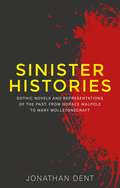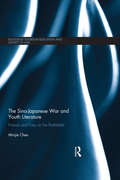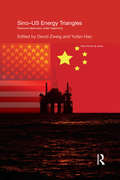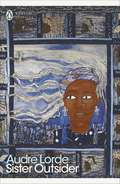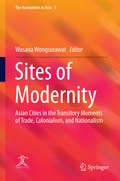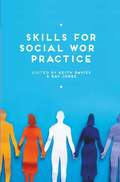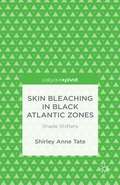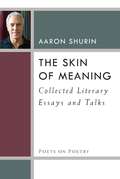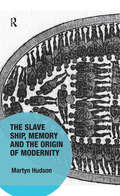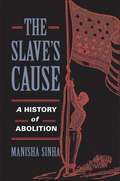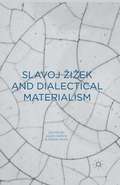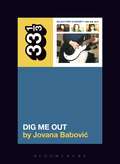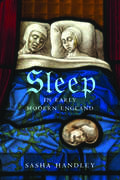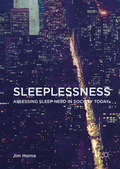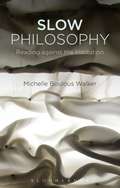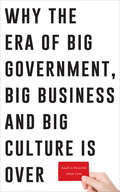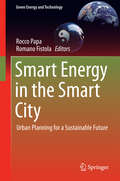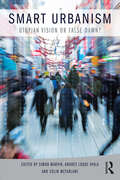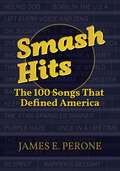- Table View
- List View
Sinister histories: Gothic novels and representations of the past, from Horace Walpole to Mary Wollstonecraft (PDF)
by Jonathan DentSinister histories is the first book to offer a detailed exploration of the Gothic's response to Enlightenment historiography. It uncovers hitherto-neglected relationships between fiction and prominent works of eighteenth-century history, locating the Gothic novel in a range of new interdisciplinary contexts. Drawing on ideas from literary studies, history, politics and philosophy, the book demonstrates the extent to which historical works influenced and shaped Gothic fiction from the 1760s to the early nineteenth century. Through a series of detailed readings of texts from The Castle of Otranto (1764) to Maria, or The Wrongs of Woman (1798), this book offers an alternative account of the Gothic's development and a sustained revaluation of the creative legacies of the French Revolution.
Sinister histories: Gothic novels and representations of the past, from Horace Walpole to Mary Wollstonecraft
by Jonathan DentSinister histories is the first book to offer a detailed exploration of the Gothic's response to Enlightenment historiography. It uncovers hitherto-neglected relationships between fiction and prominent works of eighteenth-century history, locating the Gothic novel in a range of new interdisciplinary contexts. Drawing on ideas from literary studies, history, politics and philosophy, the book demonstrates the extent to which historical works influenced and shaped Gothic fiction from the 1760s to the early nineteenth century. Through a series of detailed readings of texts from The Castle of Otranto (1764) to Maria, or The Wrongs of Woman (1798), this book offers an alternative account of the Gothic's development and a sustained revaluation of the creative legacies of the French Revolution.
The Sino-Japanese War and Youth Literature: Friends and Foes on the Battlefield (Routledge Studies in Education and Society in Asia)
by Minjie ChenThe Sino-Japanese War (1937 – 1945) was fought in the Asia-Pacific theatre between Imperial Japan and China, with the United States as the latter’s major military ally. An important line of investigation remains, questioning how the history of this war has been passed on to post-war generations’ consciousness, and how information sources, particularly those exposed to young people in their formative years, shape their knowledge and bias of the conflict as well as World War II more generally. This book is the first to focus on how the Sino-Japanese War has been represented in non-English and English sources for children and young adults. As a cross-cultural study and an interdisciplinary endeavour, it not only examines youth-orientated publications in China and the United States, but also draws upon popular culture, novelists’ memoirs, and family oral narratives to make comparisons between fiction and history, Chinese and American sources, and published materials and private memories of the war. Through quantitative narrative analysis, literary and visual analysis, and socio-political critique, it shows the dominant pattern of war stories, traces chronological changes over the seven decades from 1937 to 2007, and teases out the ways in which the history of the Sino-Japanese War has been constructed, censored, and utilized to serve shifting agendas. Providing a much needed examination of public memory, literary representation, and popular imagination of the Sino-Japanese War, this book will have huge interdisciplinary appeal, particularly for students and scholars of Asian history, literature, society and education.
The Sino-Japanese War and Youth Literature: Friends and Foes on the Battlefield (Routledge Studies in Education and Society in Asia)
by Minjie ChenThe Sino-Japanese War (1937 – 1945) was fought in the Asia-Pacific theatre between Imperial Japan and China, with the United States as the latter’s major military ally. An important line of investigation remains, questioning how the history of this war has been passed on to post-war generations’ consciousness, and how information sources, particularly those exposed to young people in their formative years, shape their knowledge and bias of the conflict as well as World War II more generally. This book is the first to focus on how the Sino-Japanese War has been represented in non-English and English sources for children and young adults. As a cross-cultural study and an interdisciplinary endeavour, it not only examines youth-orientated publications in China and the United States, but also draws upon popular culture, novelists’ memoirs, and family oral narratives to make comparisons between fiction and history, Chinese and American sources, and published materials and private memories of the war. Through quantitative narrative analysis, literary and visual analysis, and socio-political critique, it shows the dominant pattern of war stories, traces chronological changes over the seven decades from 1937 to 2007, and teases out the ways in which the history of the Sino-Japanese War has been constructed, censored, and utilized to serve shifting agendas. Providing a much needed examination of public memory, literary representation, and popular imagination of the Sino-Japanese War, this book will have huge interdisciplinary appeal, particularly for students and scholars of Asian history, literature, society and education.
Sino-U.S. Energy Triangles: Resource Diplomacy Under Hegemony (Politics in Asia)
by David Zweig Yufan HaoThe remarkable performance of the Chinese economy in the last three decades has placed China at the centre of the world stage. In 1993, China became a net importer of energy, although it was not until the early 2000s that the world began to pay more attention to China’s energy needs and its potential impact on the world. With China’s energy search occurring within a hegemonic global structure dominated by the United States, the US watches with interest as China enhances its ties with energy-rich states. The book examines this triangular relationship and questions whether the US and China are in competition regarding access to the energy of a third state, within the context of a potential power transition. It includes case studies on China's energy relationship with countries such as Canada, Australia, Saudi Arabia, Nigeria, Brazil, Kazakhstan, Iran, Sudan and Venezuela and aims to understand the way a rising power interacts with the existing leading power and the possible outcome of this competition. The analytical framework employed helps the reader to understand not only the nature and pattern of triangles among US, China and the Resource Rich States under ‘resource diplomacy’, but also the salient features of US-China competition around the world. Making an impressive contribution to the literature in fields such as US-China relations, international relations, Chinese foreign policy and global energy geopolitics, this book will appeal to students and scholars of these subjects.
Sino-U.S. Energy Triangles: Resource Diplomacy Under Hegemony (Politics in Asia)
by David Zweig Yufan HaoThe remarkable performance of the Chinese economy in the last three decades has placed China at the centre of the world stage. In 1993, China became a net importer of energy, although it was not until the early 2000s that the world began to pay more attention to China’s energy needs and its potential impact on the world. With China’s energy search occurring within a hegemonic global structure dominated by the United States, the US watches with interest as China enhances its ties with energy-rich states. The book examines this triangular relationship and questions whether the US and China are in competition regarding access to the energy of a third state, within the context of a potential power transition. It includes case studies on China's energy relationship with countries such as Canada, Australia, Saudi Arabia, Nigeria, Brazil, Kazakhstan, Iran, Sudan and Venezuela and aims to understand the way a rising power interacts with the existing leading power and the possible outcome of this competition. The analytical framework employed helps the reader to understand not only the nature and pattern of triangles among US, China and the Resource Rich States under ‘resource diplomacy’, but also the salient features of US-China competition around the world. Making an impressive contribution to the literature in fields such as US-China relations, international relations, Chinese foreign policy and global energy geopolitics, this book will appeal to students and scholars of these subjects.
Sister Outsider: Essays And Speeches (Penguin Modern Classics #1)
by Audre LordeThe woman's place of power within each of us is neither white nor surface; it is dark, it is ancient, and it is deepThe revolutionary writings of Audre Lorde gave voice to those 'outside the circle of this society's definition of acceptable women'. Uncompromising, angry and yet full of hope, this collection of her essential prose - essays, speeches, letters, interviews - explores race, sexuality, poetry, friendship, the erotic and the need for female solidarity, and includes her landmark piece 'The Master's Tools Will Never Dismantle the Master's House'.'The truth of her writing is as necessary today as it's ever been' Guardian
Sites of Modernity: Asian Cities in the Transitory Moments of Trade, Colonialism, and Nationalism (The Humanities in Asia #1)
by Wasana WongsurawatThis book investigates, compares and contrasts the experience of entering into and engaging in modernity and the modern era in many parts of the Asian continent. It focuses on the coming into being, development, and transformation of major urban centers from Tokyo to Mumbai from the late 19th century to the present, providing a broad overview of this crucial period of transition in Asia, not only from diverse geographical and historical perspectives, but also incorporating a broad range of further disciplines.
Skills For Social Work Practice (PDF)
by Keith Davies Ray JonesSkills lie at the heart of all actions of a social worker, and inform all aspects of practice - from drawing on vital theoretical and ethical frameworks to applying the law and research findings to particular situations. This user-friendly and logically organised book brings together the key skills needed for practice in one place. It reflects current practice frameworks and addresses a wide range of skills including communication and relationship building, professional writing, ethical practice, assessment and reflection. Each chapter incorporates a number of features to help with learning and practical application, including: * Case studies to demonstrate how particular concepts apply to social work practice * Reflective exercises to help readers relate concepts and situations to their own experiences on placement and in the classroom * Progress checks to help students make connections between the Professional Capability Framework, the Standards of Proficiency and the wider skills they need to acquire * Chapter summaries to draw out key themes This engaging and practical book is essential for students studying social work or health and social care. It is also a critical tool for practitioners looking to enhance their skills in social work practice.
Skin Bleaching in Black Atlantic Zones: Shade Shifters
by S. TateThis book's discussion of skin bleaching, lightening and toning in Black Atlantic zones disengages with the usual tropes of Black Nationalism and global white supremacy such as 'the desire to be white', 'low self-esteem' and 'self-hatred' and instead engages with the global multi-billion dollar market in lighter skins with products from local cosmetic and pharmaceutical companies and entrepreneurs. This practice can be for short-term strategic purposes and the production of bleached lightness and new subjectivities through skin shades across Black Atlantic zones - the UK, USA, Caribbean, Latin America and the Africa continent- is also a simultaneous critique of continuing pigmentocracy and darker skin disadvantage. This book seeks to decolonize skin bleaching, lightening and toning by exploring its racialized gender political and libidinal economies in the Black Atlantic. In so doing it moves past the notion that global white supremacy dynamizes the practice to a position where the interaction of colourism and 'post-race' neo-liberal racialization aesthetics becomes the focus.
The Skin of Meaning: Collected Literary Essays and Talks (Poets On Poetry)
by Aaron ShurinA volume in the Poets on Poetry series, which collects critical works by contemporary poets, gathering together the articles, interviews, and book reviews by which they have articulated the poetics of a new generation. In The Skin of Meaning, Aaron Shurin has collected thirty years’ worth of his provocative essays. Fueled by gender and queer studies and combined with radical traditions in poetry, Shurin’s essays combine a highly personal and lyrical vision with a trenchant social analysis of poetry’s possibilities. Whether he’s examining innovations in poetic form, analyzing the gestures of drag queens, or dissecting the language of AIDS, Shurin’s writing is evocative, his investigations rigorous, and his point of view unabashed. Shurin’s poetic practice braids together many strands in contemporary, innovative writing, from the San Francisco Renaissance to Language Poetry and New Narrative Writing. His mentorships with Robert Duncan and Denise Levertov; his studies at New College of California, where he was the first graduate of the epochal Poetics Program; and his years of teaching writing provide a rich background for these essays. San Francisco provides the color and context for formulations of “prosody now,” propositions of textual collage, and theories of radical narrativity, while the heart of the book searches through the dire years of the AIDS epidemic to uncover poetic meaning, and “make the heroes heroes.”
The Slave Ship, Memory and the Origin of Modernity (Memory Studies: Global Constellations)
by Martyn HudsonTraces; slave names, the islands and cities into which we are born, our musics and rhythms, our genetic compositions, our stories of our lost utopias and the atrocities inflicted upon our ancestors, by our ancestors, the social structure of our cities, the nature of our diasporas, the scars inflicted by history. These are all the remnants of the middle passage of the slave ship for those in the multiple diasporas of the globe today, whose complex histories were shaped by that journey. Whatever remnants that once existed in the subjectivities and collectivities upon which slavery was inflicted has long passed. But there are hints in material culture, genetic and cultural transmissions and objects that shape certain kinds of narratives - this is how we know ourselves and how we tell our stories. This path-breaking book uncovers the significance of the memory of the slave ship for modernity as well as its role in the cultural production of modernity. By so doing, it examines methods of ethnography for historical events and experiences and offers a sociology and a history from below of the slave experience. The arguments in this book show the way for using memory studies to undermine contemporary slavery.
The Slave Ship, Memory and the Origin of Modernity (Memory Studies: Global Constellations)
by Martyn HudsonTraces; slave names, the islands and cities into which we are born, our musics and rhythms, our genetic compositions, our stories of our lost utopias and the atrocities inflicted upon our ancestors, by our ancestors, the social structure of our cities, the nature of our diasporas, the scars inflicted by history. These are all the remnants of the middle passage of the slave ship for those in the multiple diasporas of the globe today, whose complex histories were shaped by that journey. Whatever remnants that once existed in the subjectivities and collectivities upon which slavery was inflicted has long passed. But there are hints in material culture, genetic and cultural transmissions and objects that shape certain kinds of narratives - this is how we know ourselves and how we tell our stories. This path-breaking book uncovers the significance of the memory of the slave ship for modernity as well as its role in the cultural production of modernity. By so doing, it examines methods of ethnography for historical events and experiences and offers a sociology and a history from below of the slave experience. The arguments in this book show the way for using memory studies to undermine contemporary slavery.
The Slave's Cause: A History of Abolition
by Manisha SinhaReceived historical wisdom casts abolitionists as bourgeois, mostly white reformers burdened by racial paternalism and economic conservatism. Manisha Sinha overturns this image, broadening her scope beyond the antebellum period usually associated with abolitionism and recasting it as a radical social movement in which men and women, black and white, free and enslaved found common ground in causes ranging from feminism and utopian socialism to anti-imperialism and efforts to defend the rights of labor. Drawing on extensive archival research, including newly discovered letters and pamphlets, Sinha documents the influence of the Haitian Revolution and the centrality of slave resistance in shaping the ideology and tactics of abolition. This book is a comprehensive new history of the abolition movement in a transnational context. It illustrates how the abolitionist vision ultimately linked the slave’s cause to the struggle to redefine American democracy and human rights across the globe.
Slavoj Zizek and Dialectical Materialism
by Agon Hamza Frank RudaThis book is the first volume to bring together the most prominent scholars who work on Slavoj i ek's philosophy, examining and interrogating his understanding of dialectical materialism. It deserves to be thoroughly and systematically elaborated because it attempts to propose a new foundation for dialectical materialism.
Sleater-Kinney's Dig Me Out (33 1/3)
by Jovana BabovicSleater-Kinney's 1997 album Dig Me Out is built on Corin Tucker and Carrie Brownstein's competing guitars, Janet Weiss's muscular rhythms, and layered vocals that teeter between an urgent, banshee-like vibrato and a lower accompaniment. Dig Me Out was the band's third studio album, but the first one written and recoded with Weiss. It inaugurated Sleater-Kinney into a lineup that would span its two-decade career.This 33 1/3 follows the narrative of Dig Me Out from its inception in Olympia to its recording in Seattle and its reception across the United States. It's anchored in a short period of time – roughly from mid-1996 to mid-1998 – but it encompasses a series of battles over meaning that continued to preoccupy Sleater-Kinney in the coming decades. The band wrestled with the media about how they would be presented to the public, it contended with technicians about how their sound would be heard in clubs, and they struggled with pervasive social hierarchies about how their work would be understood in popular culture. The only instance where the band didn't have to put up much of a fight was when it came to their fans. The acclaim Sleater-Kinney received from their listeners in the late 1990s, and continue to receive today, speaks to a need for icons who challenged normative notions of culture and gender. This story of Dig Me Out chronicles how Sleater-Kinney won the fight to define themselves on their own terms – as women and as musicians – and, in the process, how they redefined the parameters of rock.
Sleep in Early Modern England
by Sasha HandleyA riveting look at how the early modern world revolutionized sleep and its relation to body, mind, soul, and society Drawing on diverse archival sources and material artifacts, Handley reveals that the way we sleep is as dependent on culture as it is on biological and environmental factors. After 1660 the accepted notion that sleepers lay at the mercy of natural forces and supernatural agents was challenged by new medical thinking about sleep’s relationship to the nervous system. This breakthrough coincided with radical changes shaping everything from sleeping hours to bedchambers. Handley’s illuminating work documents a major evolution in our conscious understanding of the unconscious.
Sleeplessness: Assessing Sleep Need in Society Today
by Jim HorneThis book critically evaluates the popular notion that today’s society is suffering from ‘sleep debt’, or what Horne calls ‘societal insomnia’ - an apparent chronic loss of sleep, which can lead to obesity and related physical and mental disorders including heart disease. It presents evidence which suggests that sleep debt has not in fact worsened to any marked extent over the last hundred or so years, by looking back at some historical writings on sleeplessness and integrating the findings with, evidence-based research that he has undertaken over the last decade. Written in a concise and understandable way, and interwoven with real-world insights, the book will be useful to academic and students of cognitive, critical and social psychology, neuroscience and sociology, as well as anyone who is interested in the social and psychological implications of sleep and sleeplessness.
Slow Philosophy: Reading against the Institution
by Michelle Boulous WalkerIn an age of internet scrolling and skimming, where concentration and attention are fast becoming endangered skills, it is timely to think about the act of reading and the many forms that it can take. Slow Philosophy: Reading Against the Institution makes the case for thinking about reading in philosophical terms. Boulous Walker argues that philosophy involves the patient work of thought; in this it resembles the work of art, which invites and implores us to take our time and to engage with the world. At its best, philosophy teaches us to read slowly; in fact, philosophy is the art of reading slowly – and this inevitably clashes with many of our current institutional practices and demands.Slow reading shares something in common with contemporary social movements, such as that devoted to slow food; it offers us ways to engage the complexity of the world. With the help of writers as diverse as Nietzsche, Wittgenstein, Woolf, Adorno, Levinas, Critchley, Beauvoir, Le Dœuff, Irigaray, Cixous, Weil, and others, Boulous Walker offers a foundational text in the emerging field of slow philosophy, one that explores the importance of unhurried time in establishing our institutional encounters with complex and demanding works.
Slow Philosophy: Reading against the Institution
by Michelle Boulous WalkerIn an age of internet scrolling and skimming, where concentration and attention are fast becoming endangered skills, it is timely to think about the act of reading and the many forms that it can take. Slow Philosophy: Reading Against the Institution makes the case for thinking about reading in philosophical terms. Boulous Walker argues that philosophy involves the patient work of thought; in this it resembles the work of art, which invites and implores us to take our time and to engage with the world. At its best, philosophy teaches us to read slowly; in fact, philosophy is the art of reading slowly – and this inevitably clashes with many of our current institutional practices and demands.Slow reading shares something in common with contemporary social movements, such as that devoted to slow food; it offers us ways to engage the complexity of the world. With the help of writers as diverse as Nietzsche, Wittgenstein, Woolf, Adorno, Levinas, Critchley, Beauvoir, Le Dœuff, Irigaray, Cixous, Weil, and others, Boulous Walker offers a foundational text in the emerging field of slow philosophy, one that explores the importance of unhurried time in establishing our institutional encounters with complex and demanding works.
Small is Powerful: Why the Era of Big Government, Big Business and Big Culture is Over
by Adam LentHumanity started small. Where did we get the idea big is better? The establishment promote big business, big government or big culture, more often than not, all three. In Small is Powerful Adam Lent reveals how our faith in big was manufactured in the 1900s – by a group of powerful business leaders, politicians and thinkers –and gripped the collective imagination throughout the twentieth century. But the notion that vast concentrations of power should reside in the state, in corporations, or the church has failed to create a stable, fairer world. In Small is Powerful, Lent challenges this failure of imagination and asks us to consider a world where ownership, power and resources are dispersed on a smaller scale, in way that is better for everyone. He explores the roots of the 'small revolution' in the 1970s, and demonstrates how, contrary to received wisdom, this movement is intensifying today. Millions are setting up their own small businesses; political and social change is increasingly delivered by grassroots initiatives; and people are making their own decisions about how to live their lives.Small is Powerful delivers an informed and impassioned plea to stand up and fight for the fairer, wealthier and more stable world we want. It is an impassioned plea for 'smallists' everywhere to stand up and be counted.
Smart Energy in the Smart City: Urban Planning for a Sustainable Future (Green Energy and Technology)
by Rocco Papa Romano FistolaThis book examines the energy dimension of the smart city from the perspective of urban planning, providing a complete overview that ranges from theoretical aspects to practical considerations and projects. In addition, it aims to illustrate how the concept of the smart city can enhance understanding of the urban system and foster new forms of management of the metropolis, including with respect to energy supply and use. Specifically, the book explores the different dimensions of the relationship between energy and the city, discusses methodological issues with a special focus on ontological approaches to sustainability, and describes practices, tools, and good examples of energy-related urban planning. The authors represent the main Italian research groups working in the field, Italy being an excellent example of a country exposed to energy problems due to, for example, vulnerability to climate change and lack of primary energy resources. This book will be valuable for students of urban planning, town planners, and researchers interested in understanding the changing nature of the city and the challenges posed by energy issues.
Smart Urbanism: Utopian vision or false dawn?
by Simon Marvin Andrés Luque-Ayala Colin McFarlaneSmart Urbanism (SU) – the rebuilding of cities through the integration of digital technologies with buildings, neighbourhoods, networked infrastructures and people – is being represented as a unique emerging ‘solution’ to the majority of problems faced by cities today. SU discourses, enacted by technology companies, national governments and supranational agencies alike, claim a supremacy of urban digital technologies for managing and controlling infrastructures, achieving greater effectiveness in managing service demand and reducing carbon emissions, developing greater social interaction and community networks, providing new services around health and social care etc. Smart urbanism is being represented as the response to almost every facet of the contemporary urban question. This book explores this common conception of the problematic of smart urbanism and critically address what new capabilities are being created by whom and with what exclusions; how these are being developed - and contested; where is this happening both within and between cities; and, with what sorts of social and material consequences. The aim of the book is to identify and convene a currently fragmented and disconnected group of researchers, commentators, developers and users from both within and outside the mainstream SU discourse, including several of those that adopt a more critical perspective, to assess ‘what’ problems of the city smartness can address The volume provides the first internationally comparative assessment of SU in cities of the global north and south, critically evaluates whether current visions of SU are able to achieve their potential; and then identifies alternative trajectories for SU that hold radical promise for reshaping cities.
Smart Urbanism: Utopian vision or false dawn?
by Simon Marvin, Andrés Luque-Ayala and Colin McFarlaneSmart Urbanism (SU) – the rebuilding of cities through the integration of digital technologies with buildings, neighbourhoods, networked infrastructures and people – is being represented as a unique emerging ‘solution’ to the majority of problems faced by cities today. SU discourses, enacted by technology companies, national governments and supranational agencies alike, claim a supremacy of urban digital technologies for managing and controlling infrastructures, achieving greater effectiveness in managing service demand and reducing carbon emissions, developing greater social interaction and community networks, providing new services around health and social care etc. Smart urbanism is being represented as the response to almost every facet of the contemporary urban question. This book explores this common conception of the problematic of smart urbanism and critically address what new capabilities are being created by whom and with what exclusions; how these are being developed - and contested; where is this happening both within and between cities; and, with what sorts of social and material consequences. The aim of the book is to identify and convene a currently fragmented and disconnected group of researchers, commentators, developers and users from both within and outside the mainstream SU discourse, including several of those that adopt a more critical perspective, to assess ‘what’ problems of the city smartness can address The volume provides the first internationally comparative assessment of SU in cities of the global north and south, critically evaluates whether current visions of SU are able to achieve their potential; and then identifies alternative trajectories for SU that hold radical promise for reshaping cities.
Smash Hits: The 100 Songs That Defined America
by James E. PeroneWe are what we listen to. That's the premise of this study of 100 songs that have shaped and defined the American experience, from the Colonial period to the present.Well-known music author James Perone looks at 100 songs that helped tell America's story. He examines why each song became a hit, what cultural and social values it embodies, what issues it touches upon, what audiences it attracted, and what made it such a definitive part of American history and popular culture.The chart-topping singles presented here crossed gender, age, race, and class lines to appeal to the mass American audience. The book discusses patriotic songs, minstrel music, and sacred songs and hymns as well as music in the broad categories of pop, rock, hip hop, jazz, country, and folk. An introduction provides an overview of the history and significant issues raised by the songs as a whole. Individual songs are then presented chronologically, based on when they were written. The revealing commentary for each "hit" is not only interesting and fun, but reveals what it was like to live in the United States at a particular time by unveiling the social, economic, and political issues—as well as the musical tastes—that made life what it was.
